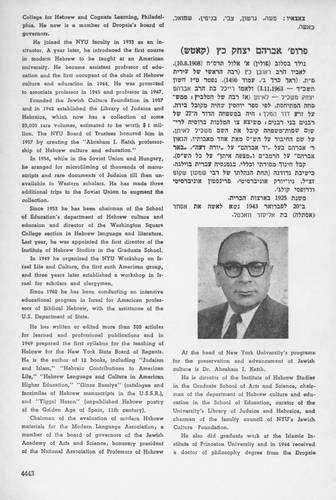צאצאיו: משה, גרשון, צבי, בנימין, שמואל, באשה.
פרופ' אברהם יצחק כץ (קאטש)
נולד בסלוב (פולין) א' אלול תרס"ח (10.8.1908).
לאביו הרב ראובן כץ (רבה הראשי של עירית פ"ת. (ראך כרך ג', עמוד 1490). נפטר ט"ז חשון תשכ"ד - 3.11.1963) ולאמו רייכל בת הרב אברהם יצחק משכיל - לאיתן (אז רבה של חסלביץ ; ממשפחה המתיחסת, לפי ספר יוחסין שהיה מקובל בידה, על זרע דוד המלך ; היה במשפחה הדור ה-27 של רבנים בני רבנים ; משיצא צו המלכות ברוסיה לרישום שמות-משפחה קיבל את השם משכיל לאיתן, על שם החיבור על הש"ס מאת אחד מאבותיו, הגאון ר' אברהם בעל "יד אברהם" על "יורה דעה", "באר "אברהם" על הרמב"ם ו"מצפה איתן" על כל הש"ס).
קבל חינוך מסורתי וכללי, בגמנסיה עברית בוילנה, בישיבת גרודנה (תחת הנהלתו של רבי שמעון שקופ זצ"ל. ניו-יורק אוניברסיטי, פרינסטון אוניברסיטי ודרופסי קולג'.
משנת 1925 בארצות הברית.
ב-20 לפברואר 1943 נשא לאשה את אסתר (אסתלה) בת אליעזר וואכטל. At the head of New York University's programs for the preservation and advancement of Jewish culture is Dr. Abraham I. Katsh.
He is director of the Institute of Hebrew Studier in the Graduate School of Arts and Science, chairman of the department of Hebrew culture and education in the School of Education, curator of theUniversity's Library of Judaica and Hebraica, and charman of the faculty council of NYU's Jewish Culture Foundation.
He also did graduata work at the Islamic Insfifute of Princeton University and in 1944 received a doctor of philosophy degree from the Dropsie College for Hebrew and Cognate Learning, Philadelphia. He now is a member of Dropsie's board of governors.
He joined the NYU faculty in 1933 as an instructor. A year later, he introduced the first course in modern Hebrew to be taught at an American university. He became assistant professor of education and the first occupant of the chair of Hebrew culture and education in 1944. He was promoted .1947to associate professor in 1945 and professor in 1937Founded the Jewish Culture Foundation in and in 1942 established the Library of Judaica and Hebraica, which now has a collection of soma 25,000 rare volumes, estimated to be worth $ 1 million. The NYU Board of Trustees honored him in 1957 by creating the "Abraham I. Katsh professorship of Hebrew culture and education." In 1956, while in the Soviet Union and Hungary, he aranged for microfilming of thousands of manuscripts and rare documents of Judaica till then unavailable to Western scholars. He has made three additional trips to the Soviet Union to augment the collection.
Since 1953 he has been chairman of the School of Education's department of Hebrew culture and educaion and director of the Washington Square College section in Hebrew language and literature. Last year, he was appointed the first director of the Institute of Hebrew Studies in the Graduate School.
In 1949 he organized the NYU Workshop on Israel Life and Culture, the first such American group, and three years later established a workshop in Israel for scholars and clergymen.
Since 1962 he has been conducting an intensive educational program in Israel for American professors of Biblical Hebrew, with the assistance of the U.S. Department of State.
He has wrilten or edited more than 300 articles for learned and professional publications and in 1949 prepared the first syllabus for the teaching of Hebrew for the New York State Board of Regents. He is the author of 12 books, including "Judaism and Islam," "Hebraic Contributions to American Life," "Hebrew Language and Culture in American Higher Education," "Ginze Russiya" )catalogue and facsimiles of Hebrew manuscripts in the US.S.R(, and "Yiggal Hazon" )unpublished Hebrew poetry of the Gdiden Age of Spain, 11th century(.
Chairman of the evaluation of modern Hebrew materials for the Modern Language Association, a member of the board of governors of the Jewish Academy of Arts and Science ; honorary president of the National Association of Professors of Hebrew


